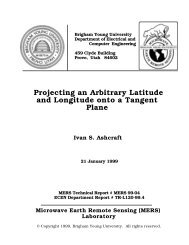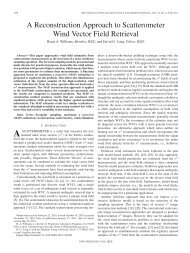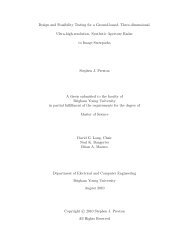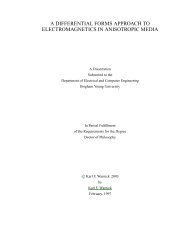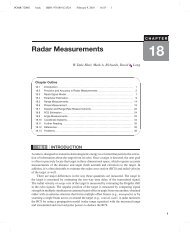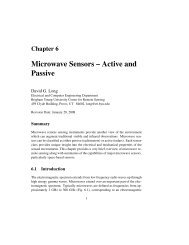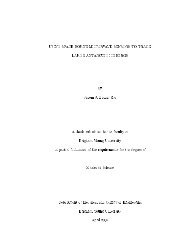Satellite Remotely Sensed Ocean Surface Vector Winds
Satellite Remotely Sensed Ocean Surface Vector Winds
Satellite Remotely Sensed Ocean Surface Vector Winds
Create successful ePaper yourself
Turn your PDF publications into a flip-book with our unique Google optimized e-Paper software.
Abstract. In 2002, a National <strong>Ocean</strong>ographic Partnership Program project was<br />
initiated with the ambitious objective of maximizing the use of currently and soonto-be-available<br />
satellite ocean surface vector wind (OSVW) data, such as NASA’s<br />
QuikSCAT scatterometer, in the operational weather forecasting and warning<br />
environment. This effort brought together people from the operational forecasting<br />
and satellite remote-sensing communities, academia, and the private sector. This<br />
diverse gathering of skill and experience yielded documentation of the impacts of<br />
these data in the operational short-term warning and forecasting environment of the<br />
National <strong>Ocean</strong>ic and Atmospheric Administration’s (NOAA’s) National Weather<br />
Service, improvement in the use of these data in the public and private sectors, and<br />
the transition of promising research results into the operational environment. This<br />
project helped create momentum that has continued to grow long after the formal<br />
effort ended; today, NOAA uses QuikSCAT operationally and is investigating how to<br />
best establish a sustained satellite OSVW observing capability.<br />
Introduction<br />
Aeronautics and Space Administration<br />
The ocean comprises over 70% of<br />
(NASA) launched QuikSCAT, a<br />
Earth’s surface, which makes satellite microwave radar system known as a<br />
remote sensing a logical and significant scatterometer, specifically designed to<br />
component of an overall effort to meet retrieve OSVW over the global ocean (Jet<br />
societal needs for weather and water Propulsion Laboratory, 2006). Prior to<br />
information; support commerce with launch, NASA’s Jet Propulsion Laboratory<br />
information for safe, efficient, and (JPL) and the National <strong>Ocean</strong>ic<br />
environmentally sound transportation; and Atmospheric Administration’s<br />
and provide information for better (NOAA’s) National Environmental<br />
coastal preparedness. <strong>Ocean</strong> surface <strong>Satellite</strong>, Data, and Information Service<br />
vector winds (OSVW) are crucial pieces (NESDIS) worked together to implement<br />
a near-real-time OSVW processing<br />
of information needed to understand<br />
and predict the short-term and longerterm<br />
processes that drive our planet’s allow QuikSCAT data to be used by<br />
and distribution system at NOAA to<br />
environment. As the largest source of the operational weather forecasting<br />
momentum for the ocean surface, winds and warning communities around the<br />
affect the full range of ocean movement,<br />
from individual surface waves to the first scatterometer launched into<br />
world. Although QuikSCAT was not<br />
complete current systems. <strong>Winds</strong> along space (Naderi et al., 1991; Stoffelen and<br />
the ocean surface regulate interaction Anderson, 1993; Gelsthorpe et al., 2000;<br />
between the atmosphere and the ocean Verhof and Stoffelen, 2008), its reliability,<br />
high quality, relatively fine spatial<br />
via modulation of air-sea exchanges of<br />
heat, moisture, gases, and particulates. resolution, and large daily geographical<br />
With the ocean covering almost three coverage resulted in its having the largest<br />
quarters of Earth’s surface, this interaction<br />
has significant influence on global in the operational marine weather<br />
impact of any scatterometry mission<br />
and regional climate.<br />
forecasting and warning world (Jelenak<br />
On June 19, 1999, the National<br />
and Chang, 2008).<br />
In 2002, a National <strong>Ocean</strong>ographic<br />
Partnership Program (NOPP) project<br />
was initiated to exploit the currently and<br />
soon-to-be-available satellite OSVW data<br />
in the operational weather forecasting<br />
and warning environment. This effort<br />
had three main objectives: (1) to quantify<br />
the impacts of QuikSCAT OSVW data in<br />
the operational short-term warnings and<br />
forecasts issued by the National Weather<br />
Service (NWS) <strong>Ocean</strong> Prediction Center<br />
(OPC) and National Hurricane Center<br />
(NHC), (2) to improve the use of satellite<br />
OSVW data in the public and private<br />
sector, and (3) to transition promising<br />
research products toward operational<br />
use. This project brought together<br />
people from the federal government,<br />
private industry, and academia and initiated<br />
what has become one of the most<br />
successful transitions of a research data<br />
stream (QuikSCAT OSVW) into operational<br />
use, where it continues to have<br />
a profound impact on marine weather<br />
warning and forecasting.<br />
Operational Use<br />
In the United States, NWS is responsible<br />
for providing marine weather<br />
warning and forecast information,<br />
and it has international obligations to<br />
provide the same within its areas of<br />
responsibility under the umbrella of the<br />
World Meteorological Organization.<br />
Additionally, the US military provides<br />
marine weather forecasting and warning<br />
services to support military operations.<br />
A combination of the NWS areas of<br />
responsibility with those of the military’s<br />
Joint Typhoon Warning Center (JTWC)<br />
provides coverage of much of the world’s<br />
ocean (Figure 1).<br />
With only a very limited number<br />
of open-ocean buoy and ship reports<br />
<strong>Ocean</strong>ography June 2009 195



